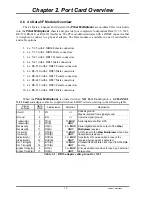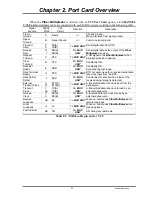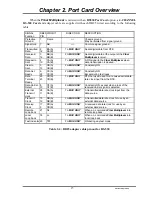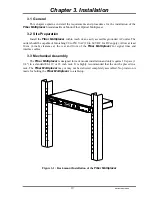
Chapter 2. Port Card Overview
17
Version 1.2 Apr 2006
2.7 Ethernet Bridge Module Option
When the
Fiber Multiplexer
is ordered with an
ET100 Port Card
option, a Single-Channel
Bridge Port Card is supplied. Complete bridging functions are provided.
BRIDGE FEATURES
10BASE-T/100BASE-TX, Full Duplex or Half Duplex
HP Auto-MDIX, detects and corrects crossed cables
IEEE 802.3x flow control available
Real-time filtering with 256 address tables
Automatic address learning, aged and deleted with 5 minutes
Up to 340 packet-buffering capacity
Auto pads undersize packets to meet the minimum LAN packet size requirement
Buffering modes can be selected according to the set of WAN and LAN line speeds
Automatic TP polarity correction
Supports passing of VLAN tab packets
BRIDGE SPECIFICATIONS
Compliance
:
IEEE
802.3/802.3u
Connector
:
Shielded
RJ-45
Data Rate
:
10/100Mbps;
Half
Duplex (20/200Mbps; Full duplex)
Filtering and Forwarding
: wire
speed
Delay
:
1 frame
WAN Protocol
: HDLC
Filter:
When this feature is disabled (DIP1-1 OFF), all frames are passed transparently. In this
configuration, the
ET100
acts as an Ethernet repeater. When the filter is enabled (DIP-1 ON),
frame destinations are tested against the internal MAC address table. Filtering enabled is the normal
selection for Bridging. When operating with modern switching HUB equipment, there is no need to
enable the filtering function as the switching HUB will do the necessary filtering. In repeater mode,
the small MAC address table (256) is not required and the unit can function in a large network
without regard to MAC filtering. The module is set to repeater mode from the factory.
Auto Negotiation:
When this feature is enabled (DIP1-3 OFF), the LAN Duplex (DIP1-4) and Speed (DIP1-5)
settings are ignored. In this default setting, the bridge will try to determine the proper speed and
duplex mode of the connected device. This is the preferred method of configuration, and does not
require the specific knowledge of the capabilities of the device to which the bridge is connected.
For legacy equipment that does not support auto-negotiation, it is highly recommended to place
DIP1-3 in the ON position and manually adjust the LAN duplex (DIP1-4) and speed (DIP1-5)
configuration settings. Failure to make the proper Ethernet settings can result in reduced LAN
performance or in worst case, no LAN function at all.
















































